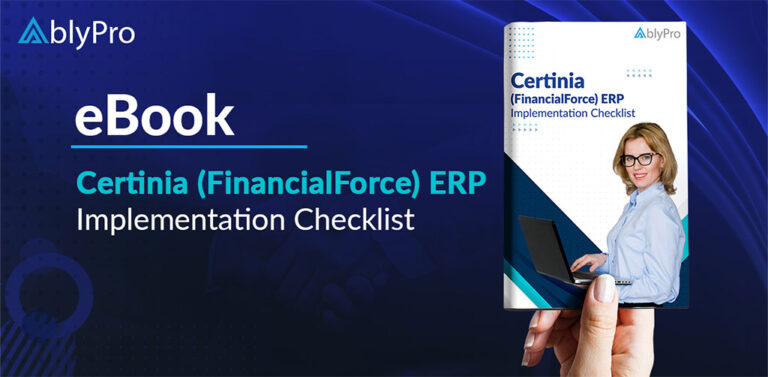Implementing a new ERP system is a risky job, with challenges lurking around every corner. You might be concerned about causing organizational upheaval, overruns in budget, project delays, or, worse, a lapse in business performance that results in lost revenue or consumers. The good news is that if you approach your ERP Software Implementation plan with a well-designed strategy and a realistic plan, you will surely achieve success. Here are some crucial ERP Implementation best practices to follow if you want to assure the success of your ERP Implementation approaches.
Best Practices for ERP Implementation

Here are some best practices for ERP Implementation to follow:
1. Start the Implementation Process with a Dedicated Team
The experience and quality of the project team are critical to the success of ERP deployment. When putting together a team, examine if the right individuals are available internally or whether the process should be outsourced to a third party – or a combination of the two. Whatever you pick, your team should comprise an executive sponsor, a project manager, and members from important business areas who clearly understand business processes, are respected by executive management, and collaborate well.
The implementation team will assist in the establishment of top-level goals, requirements, and KPIs (Key Performance Indicator), and day-to-day project management to ensure that the project is completed on time and within budget. Let’s discuss some pointers to keep in mind.
- Choose project members based on their abilities and talents rather than their job titles.
- Team members must be able to communicate with a variety of stakeholders and be courageous enough to raise contentious issues, such as asking for solutions from the ERP vendor.
- While staying open to requests for process changes or improvements, an ERP project manager should have the self-control to stick to the implementation strategy.
- You must ensure that team members are available for the project’s implementation.
- Throughout the implementation phase, consult with cross-functional and end users to ensure that each department’s concerns are addressed early on.
2. Create a Project Management Plan
It is well-known fact that planned project management is required to meet business objectives, resolve challenges effectively and quickly, and ensure overall ERP implementation Plan success. It may include the following:
- Understanding important stakeholders’ needs and concerns and providing chances for involvement.
- Creating an ERP implementation approaches and strategy specifying the project’s scope, budget, and timing.
- Performing risk assessments and planning for eventualities.
- Setting up regular update meetings to keep everyone up to date on the project’s progress and to handle difficulties.
- Creating a learning atmosphere during the training time.
- Changing business processes to make use of the ERP system’s capabilities.
3. Secure Executive Buy-in and Support
As we know, ERP system implementation requires two major resources-time and money. It is critical to have top management support to ensure that the project has the necessary resources and is aligned with overarching business objectives.
4. Prepare for Data Migration
In layman terms, data migration is typically a risky and time-consuming process, especially while transferring data from multiple applications to a new ERP system. So, it becomes very important to build a robust and methodical strategy to transfer data and to prevent the loss or corruption of important data. Here are few things you should consider doing:
- First, you need to create a migration team that can identify which data has to be migrated, how it should be moved, and how it should be cleaned up.
- Second, prepare to test for any issues by having users go through their whole day-to-day processes on the new ERP system.
- Lastly, examine source systems for obsolete data, redundancies, and inconsistencies, and make a decision.
5. Cooperate and Communicate
To guarantee that the new software is properly installed, everyone must thoroughly understand why the system is required, what it will do, what benefits it will provide, and what to expect during the onboarding process. To attain this understanding, you must foster trust and encourage active communication within your organization. You must maintain communication with your business partners throughout the process and explain how the changes may affect them.
6. Provide Comprehensive Training
The quality and quantity of user training can make or break your ERP deployment process. Some businesses expect consumers to understand the new system right away, but this is unrealistic. To maximize the benefits of ERP software adoption, it is vital that staff understand the new processes and procedures that come with it, how the system works, and how it may help them optimize processes.
Adequate training is required to ensure that end users can utilize the new technology properly. This includes providing both technical training on the system itself as well as training on any new business processes or procedures that have been implemented.
Additionally, you should also organize some solid training programs for your employees that are tailored according to their job’s positions like project team training, IT team training, communication training, etc.
7. Provide Ongoing Assistance
There are high chances that several issues will occur when the software solution will go live, and clients would start asking questions and seeking assistance. Hence, the project team should be prepared for such a situation and be capable of recognizing issues and proposing customized solutions.
Also, there can be situation where employees encounter the same issues or roadblocks. It’s usually a sign that a specific issue needs to be addressed via extra training or a system update. It is one of the best practices for ERP Implementation Plan to provide support to employees ahead of time like help desk support, knowledge base, and online forums to help them speed up their performance.
8. Collect End-User Feedback
Begin collecting input from end users early on to ensure that the entire implementation process runs well. Feedback can help you obtain vital insights into the challenges employees face in the early phases, allowing you to fix them in a timely manner before “going live.”
It will also showcase how your company’s employees work and connect with clients, and how you can enhance those relationships. In addition, gathering input will also help in guiding the ERP deployment so that the system can fulfill the needs of real users.
Free eBook
Certinia (FinancialForce) ERP Implementation Checklist

This eBook Will Cover
- The right approach to Certinia ERP Implementation.
- Steps of ERP Implementation – Pre-planning, Consulting, Training, Pilot, Go Live, and Maintenance processes.
- How ERP Implementation can guarantee your business success?
- Learn about Specific details within every step to ensure you give your business the best chance to reap the full benefits of the platform.
To Sum Up
Selecting the right ERP software and properly adopting it remains one of the most difficult tasks for businesses, requiring careful planning and the utmost attention from all stakeholders. Implementing an ERP system will always present its own set of difficulties and problems. Having a team of skilled implementation partners will make your process smoother and more manageable. To discover more about how we guide organizations through their full ERP journey, schedule a meeting with an AblyPro consultant.
Author

Project Manager, AblyPro
Manish Maid is a FinancialForce Project Manager at AblyPro with deep technical expertise in handling Enterprise Resource Planning software for optimizing Financial Management, Account Receivables, Account Payables, and other finance functions. With over 25 years of experience in training, implementation, business accounts and operations management, Manish enables organizations to simplify and streamline accounting complexities to optimize business processes while improving operational efficiency and boosting customer satisfaction.





